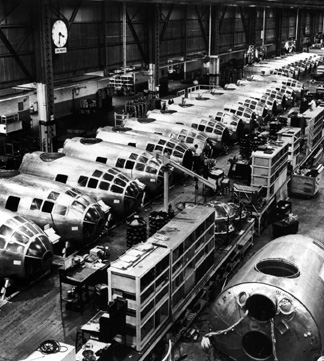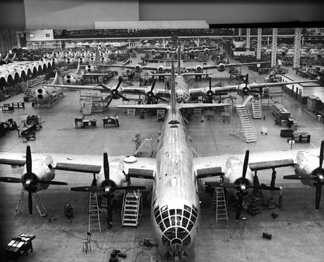|
by Wayland Mayo Author’s Introduction — Chapter 1 Page 1 of 2 Pages |
|||||||
|
manufacture date to its final tragic end. A Superfortress Is Born |
|||||||
| On a very cold January day in 1944 near Seattle, A beautiful silver bullet rolled off the assembly line at the Boeing-Renton plant. This gleaming aircraft was a B-29A, powered by four R-3350-57 engines, each developing 2200 hp. The A model, of which 1,119 were built, differed from the original B-29. The center wing section was modified, the 20mm cannon was removed from the tail, and two 50 cal. guns were added to the upper forward turret. This gave the A- model 12 - 50 cal. guns mounted in remote controlled turrets, each gun with 1,000 rounds of ammo.
What a magnificent sight. Known as the “Superfortress,” it had a 142 foot wing span, with a maximum speed of 357 mph at 30,000 feet. Everything about this aircraft was the absolute latest in technology, as Boeing engineers had designed sophisticated systems never before seen. The front and rear crew sections were pressurized, connected by a tube which ran over the two huge bomb bays. Even the tail gunner had a separate pressurized compartment. The remote controlled gunnery system was an engineering masterpiece. This particular aircraft was delivered to the Air Force on 31 January, 1944, bearing the serial number 42-94000. In Feb. 1944 it was flown to the Denver Modification Center where it was modified to an F-13A photographic plane. A total of 117 B-29A models were modified to carry a tri-metrogon set up consisting of three K-17B 6 inch cameras, two K-22 cameras with focal plane shutters mounted in a fixed mount, and an adjustable mount which would hold a variety of cameras. |
|||||||
 |
|||||||
|
Below: This photo illustrates the final assembly of the B-29B model at the Boeing-Renton Plant. This was a modification of the A-model in which all gun turrets and the remote controlled firing system were removed. Only the tail gun position remained. The F-13s (later known as the RB-29s) were remodeled from the B-29A configuration. Photos ctsy. Boeing Archives |
|||||||
 |
|||||||
| Later, in 1948, the F-13A was redesignated to a RB-29A. After modification to F-13A in Denver, 42-94000, normally referred to as 4000, was assigned to the Second Air Force in Herrington, Kansas.
[Editor’s Note: If you wish to view more details of the camera configurations End of Page 1 of 2 Pages, Chapter 1 — Go to Page 2 Cover Page — Intro/Table of Contents — Chapt. 1 or |
|||||||